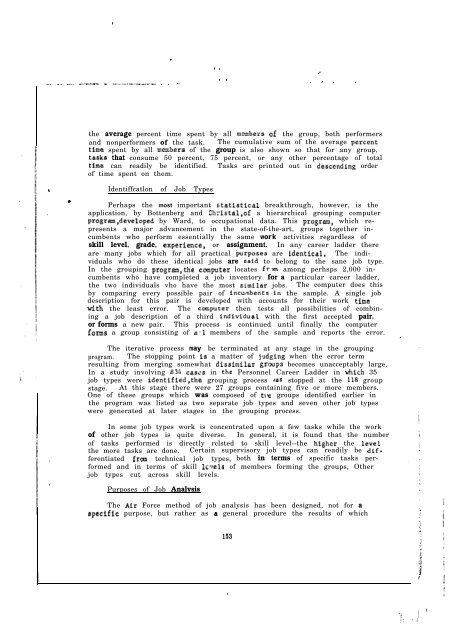Technical Report - International Military Testing Association
Technical Report - International Military Testing Association
Technical Report - International Military Testing Association
You also want an ePaper? Increase the reach of your titles
YUMPU automatically turns print PDFs into web optimized ePapers that Google loves.
___ _- .__. _.._-._-. - ._.........I._.___._ _ _<br />
.<br />
.<br />
_<br />
. .<br />
. .<br />
I<br />
. ,. . .<br />
the average percent time spent by all mcrmbers of, the group, both performers<br />
and nonperformers of the task. The cumulative sum of the average percent<br />
tfne spent by all mmbera of the group is also shown so that for any group,<br />
tasks that consume 50 percent, 75 percent, or any other percentage of total<br />
tima can readily be identified. Tasks arc printed out in descending order<br />
of time spent on them.<br />
. Identiffcatlon of Job Types<br />
.<br />
.<br />
,<br />
Perhaps the most important statistfcal breakthrough, however, is the<br />
application, by Bottenberg and ChcLstal,of a hierarchical grouping computer<br />
progrsm,developed by Ward, to occupational data. This progrsm, which represents<br />
a major advancement in the state-of-the-art, groups together incumbents<br />
who perform essentially the same work activities regardless of<br />
skill level, grade, experfence, or assignment. In any career ladder there<br />
are many jobs which for all practical purposes are identfcal. The individuals<br />
who do these identical jobs are oaid to belong to the sane job type.<br />
In the grouping program,the ccmputer locates frm among perhsps 2,000 incumbents<br />
who have completed a job inventory for a particular career ladder,<br />
the two individuals vho have the most similar jobs. The computer does this<br />
by comparing every possible pair of fncumbents,ln the sample. A single job<br />
description for this pair is developed with accounts for their work tfmc<br />
with the least error. The ccxsputer then tests all possibilities of combining<br />
a job description of a third irdividual with the first accepted pair,<br />
or forms a new pair. This process is continued until finally the computer<br />
forss a group consisting of o,l members of the sample and reports the error.<br />
The iterative process may be terminated at any stage in the grouping<br />
program. The stopping point la a matter of jgldgfng when the error term<br />
resulting from merging somewhat dissinflar groups becomes unacceptably large,<br />
In a study involving 836 cases in the Personnel Career Ladder in vhich 35<br />
job types were identifled,the grouping process #as stopped at the 118 group<br />
stage. At this stage there were 27 groups containing five or more members.<br />
One of these groups which was composed of ttu, groups identified earlier in<br />
the program was listed as two separate job types and seven other job types<br />
were generated at later stages in the grouping process.<br />
In some job types work is concentrated upon a few tasks while the work<br />
of other job types is quite diverse. In general, it is found that the number<br />
of tasks performed is directly rclsted to skill level--the higher the level<br />
the more tasks are done. Certain supervisory job types can readily be differentiated<br />
fras technical job types, both in terms of specific tasks performed<br />
and in terms of skill lc*Jels of members forming the groups, Other<br />
job types cut across skill levels.<br />
Purposes of Job Analysis<br />
The Af.r Force method of job analysis has been designed, not for a<br />
speciffc purpose, but rather as R general procedure the results of which<br />
153<br />
.<br />
-, .I ! ’<br />
,]: ,/









